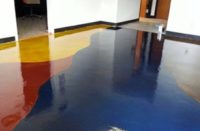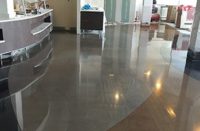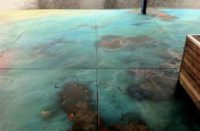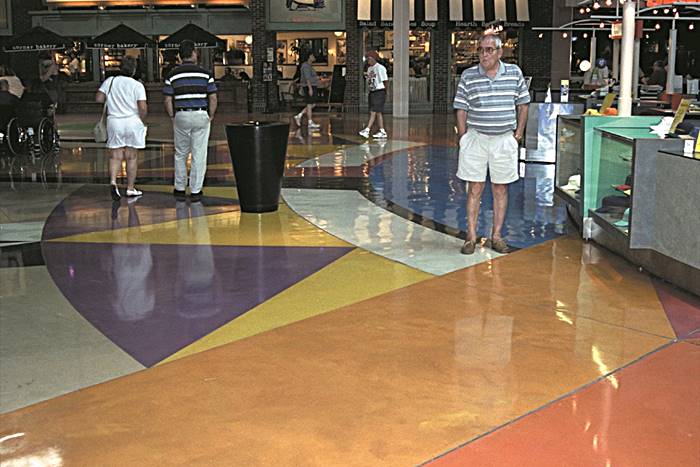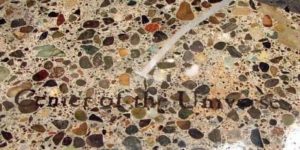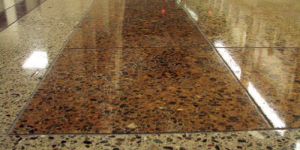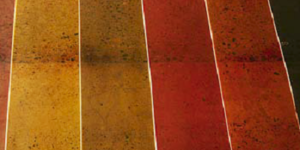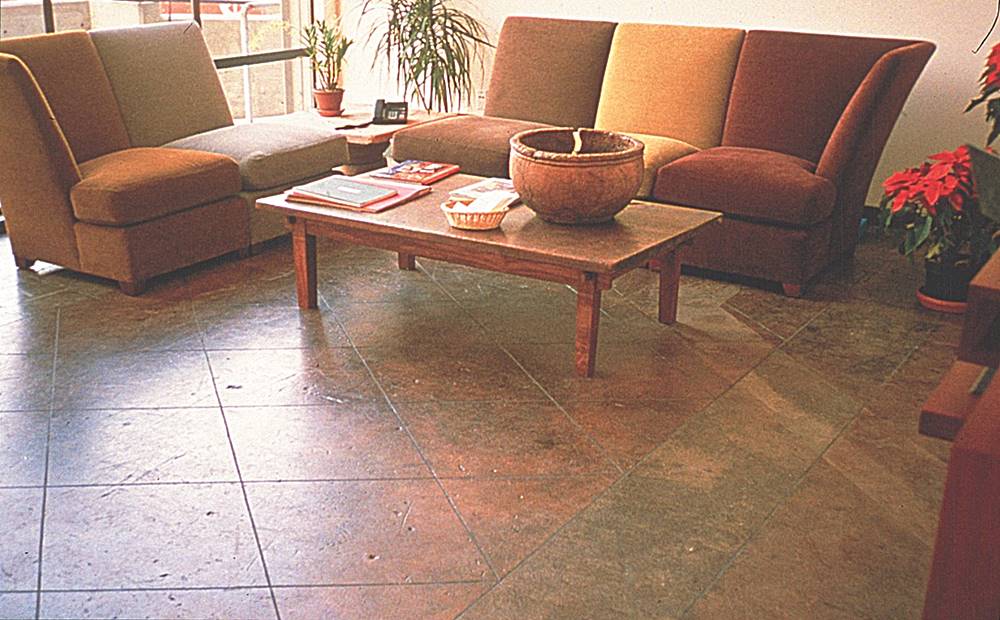
No one wants to remain a dullard forever. Concrete is no exception. Blandly gray to the eye but reliable in use, traditionally it has been relegated to basements, garages, driveways and walkways as a functional surface, not a decorative one. Yet, coloring concrete is coming into its own. Today, contractors and developers are specifying and installing intricately textured cast concrete into foyers, lobbies, garden pathways, and even countertops. But what about the cubic yards of already-installed humble gray matter? Are these surfaces doomed to remain forever mundane?
Chances are, you’ll have clients who will want to update their existing concrete surfaces from functional to fashionable. With the help of a high-quality concrete stain or refinishing product and some creativity, you can now engineer a complete makeover of the dull kid on the block. This product category offers a wealth of opportunities for contractors.
The Skinny on Stains
In the past, people seeking style have often opted to paint concrete surfaces. Particularly in the 1950s and ‘60s, patios, garages and basement recreation rooms sported bright-colored paint to disguise fundamentally functional surfaces. But paint, as you know, can sometimes need lots of attention. Paint sits atop the concrete and covers the natural surface texture. Since the paint does not penetrate the concrete surface, it can eventually fail because of the substrate’s inherent moisture. In fact, Sherwin-Williams’ experts report that concrete’s moisture content rarely dips below 15 percent, even in existing installations.
Thus, as moisture attempts to escape the opaque coating, it forces cracks, peeling and blistering in the coating film. The traditional definition of a stain is a “transparent or semi-transparent solution or suspension of color matter in a vehicle designed to color a surface by penetration without hiding it”. And for this reason, today’s concrete stains offer some definite aesthetic and performance benefits. Concrete stains penetrate the porous surface and add color without hiding the concrete’s natural texture. These penetrating coatings shift with the concrete and allow the substrate to breathe.
Color is Key
“A painted surface is just that — an opaque painted surface,” says Bill Shorey of Spec-West, a Sacramento, CA-based concrete products distributor. “It gives you a specific hue or color.”
“Staining doesn’t deliver a specific color because it is a reactionary process,” he explains. “The concrete itself actually gives you the final look. Depending on how old the concrete is and the condition it is in when you start out can make a lot of difference. The stain can enhance and intensify the discoloration and marks in the concrete. A lot of people want that variegated ‘Old World’ look.”
Shorey uses wood stain as a comparison. Both concrete and wood are highly porous surfaces. As a result, penetrating stains don’t cover the substrate uniformly. Instead the coatings infiltrate the substrate’s pores and almost literally color the inner surface, as well as the outside one.
“If you have an unblemished surface with a good grain you can intensify the grain,” Shorey explains. “Concrete isn’t just gray. You have high and lows, lights and darks, stains and black marks. When you stain it, the stain accents those different imperfections unless you put down a topcoat. It’s not a smooth, unbroken finish.”
Easy Acrylic
Clean air regulations and a concern for the environment have brought about a new generation of improved water-based acrylic stains. These products are easy to apply and they clean up with soap and water. They have low odor and also have a low volatile organic compound (VOC) content. This is a key requirement for states with strict emissions regulations like Arizona and California.
Popular water-based concrete stains include Safety Stain II from Flex Art Company, Mason’s Select Transparent Concrete Stain from Duckback Products and the H&C system of concrete care products from The Sherwin-Williams Company.
Acrylic resins in a water base typically compose the stains in the lines. This formulation allows the stains to penetrate deeply into the concrete surface and adhere to the concrete to bring out color.
Another option, polymer refinishing systems — such as Concrete Solution’s Ultra Surface Concrete Polymer — change the chemistry of regular concrete, causing mixtures of cement, sand, water and the polymer to adhere or bond tenaciously to an existing surface. Similarly, Micro-Top from Bomanite, a combination of liquid polymer and a colored powder, can be applied to create surface uniformity or be blended to create an eye-catching variegation.
Limitless color combinations and graphic designs can be used to transform existing concrete and other materials into art forms without affecting surrounding materials and fixtures. Most water-based stains and overlay systems come in at least 40 colors, as well as custom colors, expanding color choices immensely over traditional acid or chemical stains, which come in a range of about eight earthtone-inspired shades.
Acid Trip
Traditional acid or chemical stains, Shorey says, yield the best-variegated finish with a nice wash of color. However, as Luposello notes, such stains can be challenging to use and offer less protection than water-based counterparts. Nevertheless, acid/chemical stains have many fans because of the stylish effects they bring to concrete surfaces. They do not have as deep of a penetration as the water-based products, but instead derive their coloration through chemical reactions between their components and the aggregate to which they are being applied. Because of various environmental and air quality issues, today’s acid and chemical stains generally contain some sort of water component.
Acid stains, such as Blush Tone from Brickform/Rafco Products, Lithochrome Chemstain from L. M. Scofield Co., Rare Earth® Stains, Bomanite Chemical Stain, ChlorStain from SuperStone, Kemiko Concrete Stain, and QC Patina, to name a few, chemically color concrete surfaces by combining the metallic ions with particles in the concrete to form oxides. The acid in the stains lightly etch and penetrate existing concrete, allowing the ions to form permanent insoluble chemical precipitates that remain in the concrete’s pores.
Repair, Prepare and Refinish
To ensure a good topcoat integrity, any concrete surface that is to be refinished, whether it is a floor, walkway, or even a countertop, must be clean and porous. As in any job, the age-old mantra of good surface preparation is key.
First, clean the concrete to remove any grease, oil, paint or other contaminant that would inhibit the penetration of the stain. Then test the surface to see if it needs to be “etched” or sanded in order to permit the coating to apply easily. Luposello suggests feeling the surface and comparing it to a piece of 120-grit sandpaper. “If it feels the same, then it’s OK,” he advises. “If not, the surface needs to be ‘etched.’”
When using a water-based product, some experts recommend using use a 10:1 solution of muriatic acid and water or a similar product. This process, called acid etching, opens the surface of the concrete to allow good adhesion and penetration. Rinse thoroughly several times and allow the surface to dry completely.
Other professionals advise against acid etching. Instead they suggest using one of the many commercial concrete preparation cleaners or strippers on the market. These products are reported to be milder but do a similar job to etching. The preparations are designed to remove dirt, grease and oil from the surface to be stained.
Acids and Stains
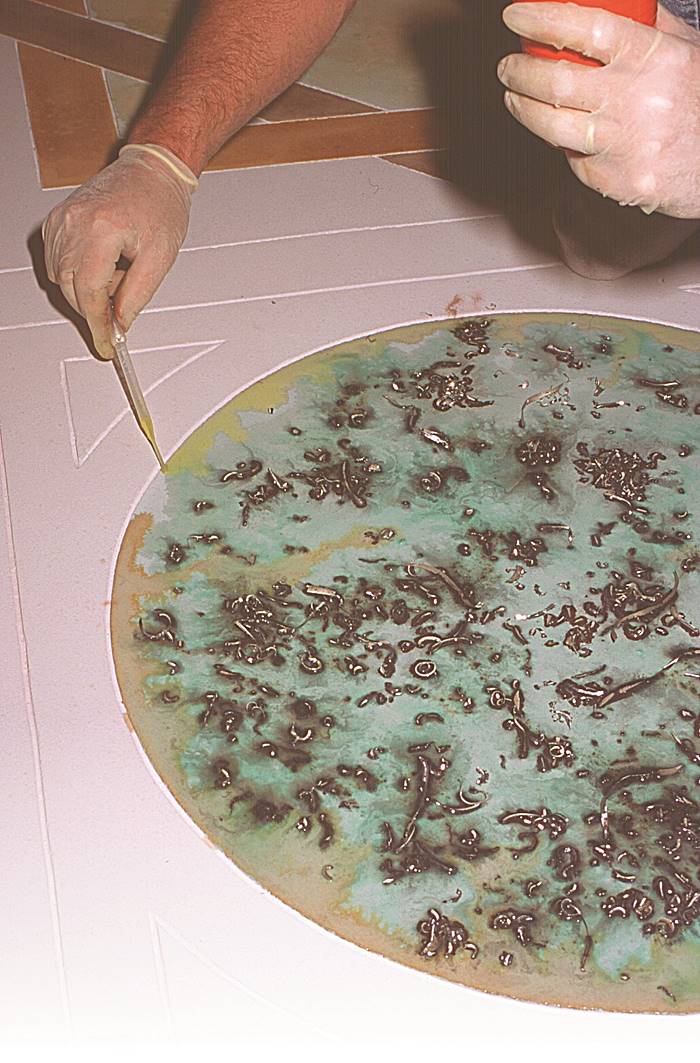 If you’re coating with a chemical stain, do not use muriatic acid. The purpose of using muriatic acid is to get down to clean, new cement. It will “eat” away the cement and leave the aggregate. That is, the sand and stone mixed with the cement to make concrete. That is, concrete made with cement mixed with sand and stone. Because of the presence of the muriatic acid, the acid stain will not react with this treated surface. And, the aggregate will not take the color. Shorey instead recommends sanding the surface to achieve the textured finish needed to accept the chemical stain. He also likes sanding for water-based stains, he says.
If you’re coating with a chemical stain, do not use muriatic acid. The purpose of using muriatic acid is to get down to clean, new cement. It will “eat” away the cement and leave the aggregate. That is, the sand and stone mixed with the cement to make concrete. That is, concrete made with cement mixed with sand and stone. Because of the presence of the muriatic acid, the acid stain will not react with this treated surface. And, the aggregate will not take the color. Shorey instead recommends sanding the surface to achieve the textured finish needed to accept the chemical stain. He also likes sanding for water-based stains, he says.
For either acid stains or waterborne products, proper preparation for the look you want to achieve may include pebble blasting or powerwashing to ensure a clean finish. And, again, don’t forget the critical role that moisture can play, experts urge.
“The concrete must be completely dry — not just the surface,” Luposello says. “If moisture is below the surface and gets trapped below the coating, it will eventually come up, thereby ruining the job. We recommend a 24-hour drying period between preparation and application of the first coat.”
Efflorescence — the white residue caused by surfacing of concrete’s inherent salts — can be removed by a light sanding or by using a commercial masonry cleansing agent, according to the Portland Cement Association. The trade group also notes that latiance, a fine, powder-like material sometimes found on the surface of hardened concrete. This should be removed by a steel scraping tool, acid etching or sandblasting/sanding, depending upon the kind of coating you will be using.
Good to Know
Application and finishing recommendations vary from brand to brand, so it’s important to follow the manufacturer’s label instructions or tech data sheets to ensure your job is the best it can be.
As a rule, however, most water-based concrete stains look best with a two-coat application. The first coat usually will penetrate and seal the concrete but not show a great deal of color. A thin second coat, applied 12 to 24 hours later over a dry surface, will bring out most of the desired color. A third coat can intensify the color even further.
Some manufacturers recommend spray applying the first coat, using either a pump or airless sprayer. Initial application with a brush, roller or pad applicator may result in lapping. Since the concrete may absorb the first coat faster than these types of application tools can apply the wet stain.
Wait at least 24 hours to walk on floor surfaces. And, for exterior surfaces such as driveways, allow surface to dry for at least seven days before running vehicles across it. Acrylic stains are often prone to tire marking, and some vehicle tire brands contain chemicals harmful to coating products. Thus, it’s not uncommon for the finish coat to lift off the surface after a vehicle has sat on it for several hours.
Safety First
Polymer overlay systems generally can be applied with a squeegee or a trowel on the surface at a thickness of approximately 20 mils, depending on the manufacturer. These systems can give an existing concrete surface a new, fashionable color. They also can be worked into decorative textures with tools or stamps. Always consult the product label for the manufacturer’s directions and product usage recommendations.
Because chemical stains contain hydrochloric acid, always use safety goggles, rubber gloves and a rubber apron when applying acid stains. And if you’re working inside or have respiratory problems, don’t forget to wear a respirator or mask.
Two coats of acid stain deliver the best results. Whether you spray or brush depends on the manufacturer’s recommendation. Once stain is on the surface, you must scrub it in with a brush as soon as it touches the concrete. Shorey suggests waiting a minimum of four hours, or until the stain is dry, before re-coating.
When applied, acid stains will fizz. This is due to the chemical reaction with the concrete. Continue spreading the stain in a circular or figure-eight motion until the fizzing action ceases. The surface must be scrubbed and rinsed clean at least four hours after the final application,
Due to the hazardous content of the stain, all residues, runoff, cleaning water and absorbent materials must be discarded and disposed of in accordance with applicable state, local and federal regulations.
The Finishing Touch
Both concrete stain manufacturers and experienced contractors say a routine maintenance schedule for all coloring concrete jobs is key to preserving a top-quality appearance. Maintenance will vary depending on a number of factors, including intensity of traffic, UV exposure, geographic location, and weather conditions. Interior residential applications, for example, require less cleaning and maintenance than larger scale commercial projects.
The first step of this plan is sealing the surface following application and drying of the stain. In most cases, experts recommend applying two coats of an acrylic sealer. Products of this type will seal the surface, enhance the color, resist staining from foreign matter, as well as provide easy cleaning and maintenance. Be sure to follow manufacturer’s application instructions.
Acrylic sealers, however, will not provide a high-gloss surface. Nor will it prevent scuff marks from shoe soles as a commercial wax will do. While some contractors apply a coat of urethane over the sealer, Shorey says a wax coating provides an excellent final touch.
“I recommend using a good maintenance contractor to apply a wax coat,” Shorey says. “Have that person apply sealer and then put down three to four coats of wax.”
In general, the need for professional maintenance ranges from 12 to 24 months, depending on foot traffic. To assure the desired gloss level, maintenance wax coats should be applied periodically. Your stain and sealer manufacturer can provide you with the names of qualified maintenance contractors in your area.
And, keep in mind that each sealer brand will likely affect the stain coat’s color differently. Consequently, it’s important to include the sealant step in the test sample you prepare for your clients. “You don’t want to have any surprises at the end of the job,” Shorey says.
Job Site Troubleshooting
Both decorative concrete and coatings experts say they cannot stress enough the unpredictability of concrete as a substrate.
“A contractor must always test the stain/sealer in an inconspicuous spot to ensure that the desired results will be achieved before full application,” Luposello says.
But sometimes, even testing isn’t fail-safe. Concrete can simply be a fickle substrate. Shorey recalls a time when he was coloring concrete and he once sold a dark acid stain to a contractor to cover a coffee shop floor. The contractor had done test samples in an out-of-the-way area. Which resulted in a rich dark brown shade that the owner loved. After staining the entire floor, the contractor called Shorey with a problem: The entire job had come out jet black and the coffee shop owner could not live with it. The contractor, Shorey recalls, was desperate for a solution.
“Having known from experience that a diluted muriatic acid wash would lighten the acid, I offered this as an option to the contractor,” he says. Adding, “if it did not work then the next option would be to re-sand the floor, put down an overlay and/or maybe both, depending on unpredictable results when using acid stain on old concrete.”
The contractor called Shorey several days later.
“He could not thank me enough,” Shorey says. “After being coated with a mild (20:1) muriatic acid solution, the floor had come out a wonderful chocolate brown with nice mottling.”
Concrete and Dyes
Concrete dyes can also solve application problems. Shorey recommends using such a product if the finished stain job has areas that did not take stain at all. For example, a 1,500-square-foot floor stained dark green has one-or two-foot-square areas that are still pretty much bare concrete.
“It can happen with old concrete, and it happens often, even if you’ve sanded well,” Shorey says. “You can fix it by mixing the dye with denatured alcohol and fogging it in over the gray area. It is transparent and mottles in with the stain, making it look like stain… but it’s not.”
Whether you’re using acid stains or water-based formulations for coloring concrete, enhancing existing concrete surfaces requires experimentation, skill and practice to discover the multitude of colors and patterns that can be achieved. While applying concrete stains at first might be daunting, learning this skill can open new doors for your business and to your clients.
A posting on the Decorative Concrete Network forum archives perhaps sums up the benefits of using a high-quality concrete stain: “The multitude of desirable, lasting, decorative effects which are achieved by the use of stain (in lieu of paint) make for a much wiser investment, time, money, wear resistance, and lasting eye-appeal!”
